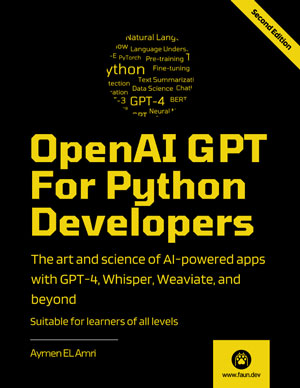
出版时间:2024.2
官网链接:Leanpub
下载地址:百度网盘(PDF+EPUB)
解压密码:asdf
内容简介:
Explore the fascinating world of Artificial Intelligence and solve real-world problems!
In this practical guide, you will build intelligent real-world applications using GPT-4, Embeddings, Whisper, Weaviate, and more tools from the OpenAI ecosystem.
You don’t need to be a data scientist or machine learning engineer to follow this guide!
About the Book
The knowledge you’ll acquire from this guide will be applicable to the current families of GPT models (GPT-3, GPT-3.5, GPT-4, etc.) and will likely also be relevant to GPT-5, should it ever be released.
OpenAI provides APIs (Application Programming Interfaces) to access their AI. The goal of an API is to abstract the underlying models by creating a universal interface for all versions, allowing users to use GPT regardless of its version.
This guide aims to provide a comprehensive, step-by-step tutorial on how to utilize GPT-3.5 and GPT-4 in your projects via this API. It also covers other models, such as Whisper and Text-to-Speech.
If you’re developing a chatbot, an AI assistant, or a web application that utilizes AI-generated data, this guide will assist you in achieving your objectives.
If you have a basic understanding of the Python programming language and are willing to learn a few additional techniques, such as using Pandas Dataframes and some NLP methods, you possess all the necessary tools to start building intelligent systems with OpenAI tools.
Rest assured, you don’t need to be a data scientist, machine learning engineer, or AI expert to comprehend and implement the concepts, techniques, and tutorials presented in this guide. The explanations provided are straightforward and easy to understand, featuring simple Python code, examples, and hands-on exercises.
This guide emphasizes practical, hands-on learning and is designed to assist readers in building real-world applications. It is example-driven and provides numerous practical examples to help readers understand the concepts and apply them to real-life scenarios to solve real-world problems.
By the end of your learning journey, you will have developed applications such as:
- Fine-tuned, domain-specific chatbots.
- An intelligent conversational system with memory and context.
- A semantic modern search engine using RAG and other techniques.
- An intelligent coffee recommendation system based on your taste.
- A chatbot assistant to assist with Linux commands
- A fine-tuned news category prediction system.
- An AI-to-AI autonomous discussion system to simulate human-like conversations or solve problems
- An AI-based mental health coach trained on a large dataset of mental health conversations
- and more!
By reading this guide and following the examples, you will be able to:
- Understand the different models available, and how and when to use each one.
- Generate human-like text for various purposes, such as answering questions, creating content, and other creative uses.
- Control the creativity of GPT models and adopt the best practices to generate high-quality text.
- Transform and edit the text to perform translation, formatting, and other useful tasks.
- Optimize the performance of GPT models using various parameters and options such as max_tokens, temperature, top_p, n, stream, logprobs, stop, presence_penalty, frequency_penalty, best_of, and others.
- Stem, lemmatize and reduce your costs when using the API.
- Understand Context Stuffing, chaining, and practice prompt engineering.
- Implement a chatbot with memory and context.
- Create prediction algorithms and zero-shot techniques and evaluate their accuracy.
- Understand, practice, and improve few-shot learning.
- Understand fine-tuning and leverage its power to create your own fine-tuned models.
- Understand and use fine-tuning best practices
- Practice training and classification techniques using GPT.
- Understand embedding and how companies such as Tesla and Notion are using it.
- Understand and implement semantic search, RAG, and other advanced tools and concepts.
- Integrate a Vector Database (e.g.: Weaviate) with your intelligent systems.